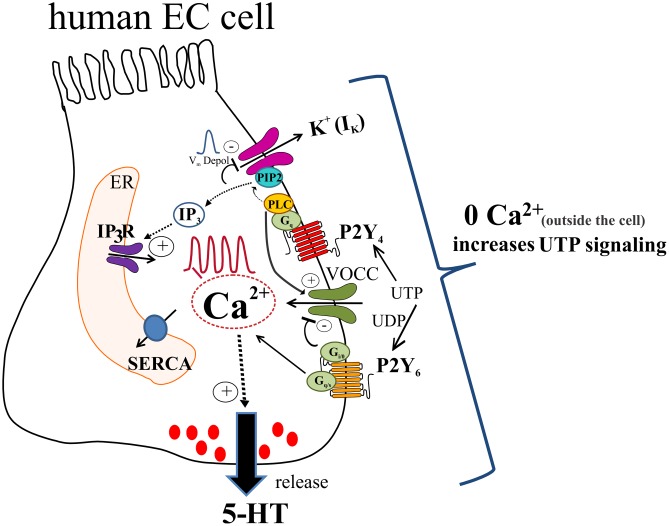FIGURE 14.
Working hypothesis of uridine nucleotide signaling in human EC cells lining the GI mucosa. UTP (or UDP) activate P2Y4 and P2Y6 receptors in EC cells to elevate intracellular free Ca2+ levels ([Ca2+]i) and generate Ca2+ oscillations or monophasic Ca2+ transients, and cause membrane depolarization. UTP acts via P2Y4 to stimulate a Gq/PLC-PIP2-IP3-IP3R/SERCA signaling pathway to elevate [Ca2+]i associated with Ca2+ responses that triggers a Ca2+ dependent 5-HT secretion in EC cells. In addition, patch-clamp studies revealed that UTP increases ICa currents by activation of VOCCs via P2Y4; P2Y6 is presumed to have an inhibitory effect on VOCCs. As well, activation of P2Y4 causes a Vm depolarization that was independent of VOCC activation, but was eliminated by the Kv7.1/7.2/7.3 channel inhibitor XE-991. We hypothesize that UTP depolarizes the cell by reducing a potassium conductance (not yet identified), which occurs as a consequence of depleting PIP2 from the membrane by its conversion to IP3 after PLC activation. Vm depolarization seems not linked to Ca2+ dependent 5-HT release but it may play a role in the fine tuning of the pathway. In a parallel way UTP reduced a component of IK currents that was insensitive to XE-991, and the identity of the Kv channel remains unknown. This response does not explain the effect of UTP on Vm depolarization. A rise in intracellular free Ca2+ is required for 5-HT release. However, zero Ca2+ buffer augments both [Ca2+]i inside the cell and 5-HT release. The mechanism for this paradoxical effect of Ca2+ influx is unknown. Concepts are based on data from a BON cell model of human EC cells. Isolated EC cells from human intestinal surgical specimens were used to confirm effect of UTP on 5-HT release and expression of P2Y4 and P2Y6 receptors.

